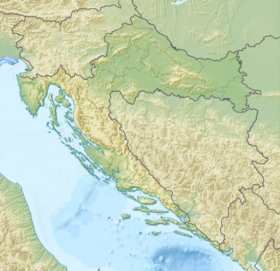Mljet ( Croatian. Mljet , Italian. Meleda , lat. Melita ) - an island in southern Croatia , near the Dalmatian coast. The first mentions of the island of Mljet are contained in the periplés of ancient Greek seafarers, whose path to the colonies on the islands of Korcula , Vis and Hvar lay through the Mljet Strait . The island of Mljet changed hands many times. The Romans used this island as a place of exile, and then it was briefly owned by the Bosnian monarchs, who sold it to Dubrovnik in 1333. In 1345-1808, the island belonged to the Dubrovnik Republic .
| Mljet | |
|---|---|
| Hor. Mljet | |
 Big lake | |
| Specifications | |
| Square | 100.41 km² |
| Highest point | 513 m |
| Population | 1111 people (2001) |
| Population density | 11.06 p / km² |
| Location | |
| Water area | Adriatic Sea |
| A country |
|
| Region | Dubrovnik Neretva County |
Geography


The area of the island is 100.41 km². The island is 37 km long and 3 km wide. The length of the coastline is 131.3 km [1] . The island of Mljet is the southernmost and most eastern of the large islands of the Adriatic . It is also the most wooded among the Croatian islands (72% of the area is wooded).
The island’s population is 1,111 people (2001), 99% are Croats. There are no big cities on the island, ships and yachts moor in the towns of Polače, Pomena and Sobra. In the western part of the island is the National Park . The eastern part of the island is known for its picturesque coves with magnificent beaches. Along the perimeter of the island is a road that facilitates its inspection. The island lies to the south of the Pelješac peninsula, from which it is separated by the Mléti Canal. On the island go from Dubrovnik and Trsteno regular and tourist flights.
National Park
The entire western part of the island is occupied by the oldest Croatian National Park “Mljet”, founded on November 12, 1960 . The main attraction of the reserve are saltwater lakes - Large (Veliko, area - 45 hectares, depth - 46 m) and Maloe (Malo, area - 24 hectares, depth - 29 m). On the Big Lake is the island of St. Mary, or, as it is called, the island on the island. On the island of sv. Mary is the eponymous old Benedictine monastery of the XII century .
The flora and fauna of the island is unique; True, over the centuries he has experienced two environmental disasters. The first was connected with a canal by which the monks in the XII century connected the Great Lake with the sea, which led to the salinization of the originally fresh lake. The second was caused by mongooses , which were brought to the island in the Middle Ages to fight numerous snakes, and which greatly reduced the livestock of not only snakes, but also wild birds, eating their eggs. However, now the island’s ecosystem has restored its balance, and wild mongoose is one of the attractions of the park.
Notes
Links
- Mljet Island (eng.)
